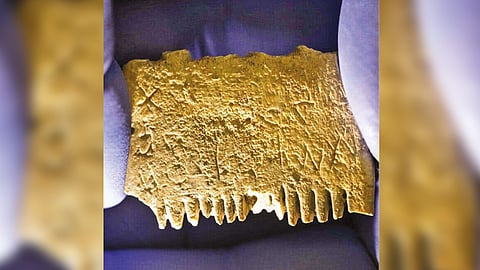

OLIVER WHANG
CHENNAI: The tiny ivory comb came from ancient ruins in central Israel and was about the size of a child’s thumb. A number of its teeth had snapped. It was so encrusted in dirt that the archaeologist who found it initially added it to a bag of assorted bones.
More than half a decade later, by a stroke of luck, scientists found letters faintly inscribed on the object: “May this tusk root out the lice of the hair and the beard.”
“People kind of laugh when you tell them what the inscription actually says,” said Michael Hasel, an archaeologist at Southern Adventist University in Tennessee who was involved in the discovery of the comb.
But those words turned out to be anything but banal. Dr. Hasel and his colleagues dated the comb to around 1,700 B.C., which means that this appeal against lice is one of the oldest examples of the writing of Canaanites, an ancient Near Eastern people credited with developing the earliest forms of the alphabet that would evolve into the letters used in this newspaper today. As the scientists explain in an article published Wednesday in the Jerusalem Journal of Archaeology, the 17 letters on the comb form the oldest full, decipherable sentence ever found in an early alphabetic script.
“I really think this is the most important object ever found in my excavations,” said Yosef Garfinkel, an archaeologist at Hebrew University of Jerusalem and a co-author of the study who has unearthed evidence of King David’s reign during his career.
He paused, then added, with a hint of emotion in his voice: “This is the first sentence ever found in the alphabet.” The earliest confirmed systems of human writing emerged around 3,200 B.C., with cuneiform in Mesopotamia and hieroglyphics in Egypt. These scripts had hundreds of letters and were largely pictorial. That made them very difficult to learn, but they spread around the Near East. At some point, probably close to 1,800 B.C., a new kind of writing appeared in the region that relied on only a few dozen letters that were repeated and shuffled around. Each letter related to a single basic sound, or phoneme.
The development of this early alphabet is not well understood. But Christopher Rollston, who studies the languages and writing systems of the Near East at George Washington University, said there was consensus that “the alphabet was invented by Semitic-speaking people who were familiar with the Egyptian writing system.”
Several centuries later, around 1,100 B.C., these earliest alphabetic scripts were adopted by the Phoenicians, who strictly wrote from right to left and standardised the shape and stance of the letters. “There is a wide misconception in the general public that the Phoenicians invented the alphabet,” Dr. Rollston said. “They didn’t.”
The alphabet continued to evolve, from Phoenician to Old Hebrew to Old Aramaic to Ancient Greek to Latin, becoming the basis for today’s modern English characters. Dr. Garfinkel said that the DNA of the earliest alphabet could still be found in English and Hebrew. For instance, the letter “A” looks a bit like a cow staring at you — two legs supporting a head. It corresponds to the Hebrew letter Aleph, which corresponds to the Semitic word for ox. “You can still see that in the ‘A,’” Dr. Garfinkel said.
Whang is a journalist with NYT©2022
The New York Times
Visit news.dtnext.in to explore our interactive epaper!
Download the DT Next app for more exciting features!
Click here for iOS
Click here for Android